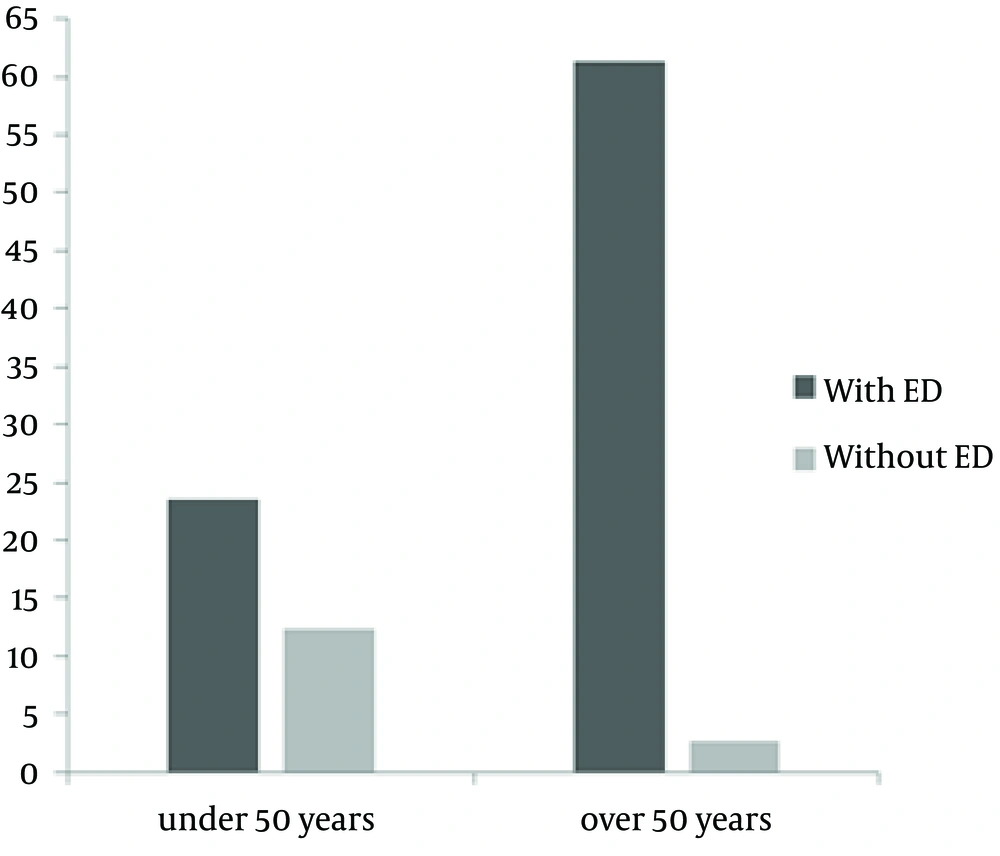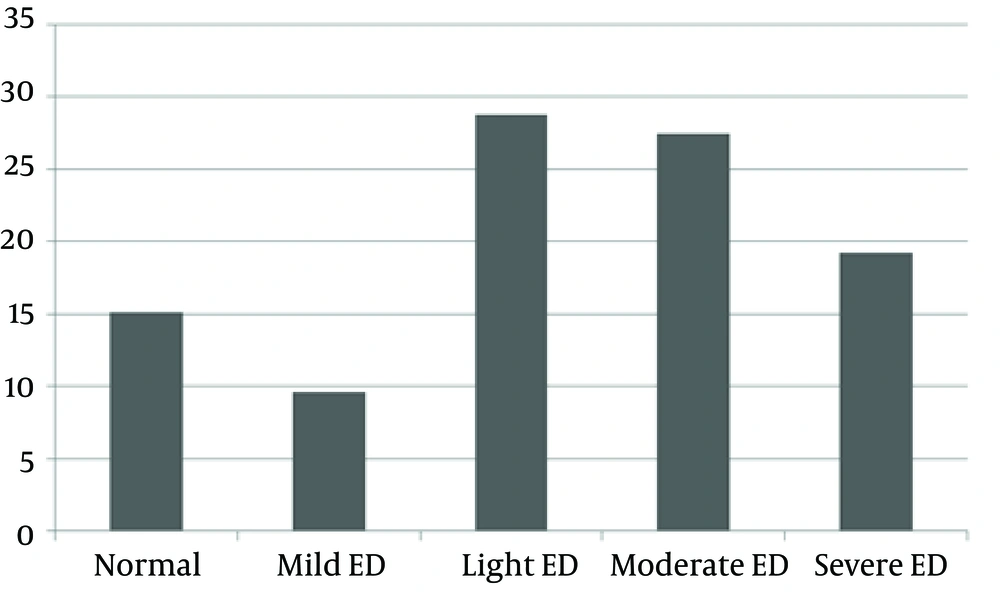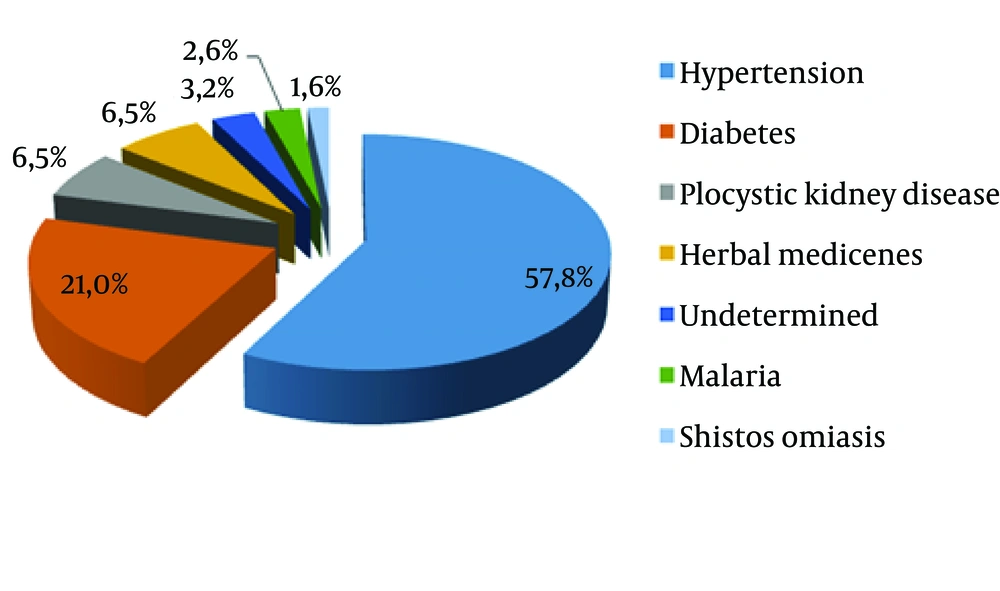1. Background
Patients with chronic kidney disease (CKD) experience multiple complications including sexual dysfunction. Erectile dysfunction (ED) is defined as the inability to achieve or maintain an erection sufficient for a satisfactory sexual intercourse (1). The severity of ED is directly correlated to the severity of CKD (2). In Africa, the true extent of ED in patients on hemodialysis remains unclear because of the taboos that surround the disease (3, 4). A previous study in the hemodialysis unit in Dakar found a prevalence rate of 81.4% (5).
2. Objectives
This study aimed to determine the current prevalence of ED, identify risk factors, assess the psychosocial effects, and evaluate the quality of the management of ED.
3. Patients and Methods
We conducted a cross-sectional descriptive multicenter study in four hemodialysis centers in the Dakar region from January 2, 2012 through April 30, 2012. All patients on chronic hemodialysis who were older than 18 years and deliberately consented to respond to questionnaire items were included. Erectile function was assessed by the short version of International Index of Erectile Function (IIEF-5) in French language, which was already validated in patients on hemodialysis. The questionnaire consisted of five items and each item was scored from one (not sure) to five (very safe). Score < 26 points was consistent with ED.
In patients with ED, four grades of severity were defined as follows: mild (score, 17-21); light (score, 12-16); moderate (score, 8-11); and severe (score, 5-7)
Collected sociodemographic data included age, sex, and marital status (single, monogamous, or polygamous). Data on dialysis parameters (dialysis vintage, type of dialysis, and number of hemodialysis hours per week), the psychosocial effects, and the different treatments were collected. The collected data were entered into Sphinx Plus2 Lexica Edition. Statistical analyses were performed with SPSS 13.0 (SPSS Inc., Chicago, IL, USA). The Chi square test was used for comparison of proportions and a P value < 0.05 was considered as statistically significant.
4. Results
From an initial target of 80 patients, 73 were included in the study. Among them, 62 presented ED according to their IEEF scores (prevalence of 84.9%). Among those who had ED, 57 were on hemodialysis and five on peritoneal dialysis. The mean age was 53.81 ± 12.52 years and most of the patients who were affected by ED problems aged 50 years (see Figure 1). Fifty-six patients (90.2%) were married (37 monogamous and 19 polygamous) and six were singles. The mean dialysis vintage was 27.3 months (range, 1-156). Periodicity of dialysis treatment was variable: thrice a week (51%), twice a week (45.5%), and once a week (3.5%). The majority of patients presented with light to moderate ED while 14 (19.2%) had severe dysfunction (Figure 2). Hypertension and diabetes were the two leading causes of initial nephropathy, which were found respectively in 59.6% and 21% of cases (see Figure 3). The associated comorbidities were consecutively hypertension (34%), decompensated heart disease (21%), and chronic viral hepatitis with hepatitis virus B (6.4%) and C (3.2%). Almost all patients (95.5%) took antihypertensive drugs, which were mainly angiotensin-converting enzyme inhibitors (64.5%), calcium channel blockers (59.6%), diuretics (45.2%), and beta-blockers (27.4%). Only 5% of cases were taking erythropoietin. Other disorders such as sexual desire disorders (55%), abnormal ejaculation (54%), and disorders of orgasm or sexual satisfaction (44%) were highlighted too. A specialized consultation was held for 26% of the patients with ED. Only 35.5% of patients were receiving treatment to improve their sexual function through taking sildenafil (24.2%) or herbal medicine (11.3%). Psychological consequences of ED in patients were dominated as anxiety (45.5%), fear of failure (22.5%), and insomnia (16%). The majority of patients (61%) received good understanding and psychological support from their partners. However, other reactions such as ignorance (13%), anger (6.4%), and resignation (4.8%) were also reported. After bivariate analysis, only age > 50 years and polygamy were significantly correlated with the risk of developing ED. Other factors such as the causal nephropathy, comorbidities, duration on dialysis, and the dialysis technique had no statistically significant association with ED (P value > 0.05).
5. Discussion
ED is a common disease with the prevalence ranging from 20% to 45% in general population. The incidence is even higher in patients on chronic dialysis due to specific risk factors such as uremic toxins, anemia, mineral and bone disorders, and antihypertensive drugs adverse effects. In this study, 84.9% of patients presented ED. These results are similar to previous data reported by Seck et al. and Nassir et al. who found respectively prevalence of 81.4% in Senegal (5) and 83% in Saudi Arabia (6). Lower prevalence of ED has been reported in patients on dialysis living in Spain (7), Brazil (8), and Netherlands (9) (respectively 60%, 54.9%, and 69%). CIGOP in 1981 showed that more than 50% of male patients with CKD showed erectile dysfunction (10) The mild and moderate grades of ED, with a prevalence of respectively 28.8% and 27.4%, were the most represented severities in our patients. Only 19.2% of patients had severe form of ED which was in contrary to previous studies in Turkey (63%) (11), Saudi Arabia (71%) (6), and USA (12). The mean age was 52.8 years old, while Seck et al. had objectified an average age of 57.7 years (5). Sixty-one percent (61.4%) patients aged 50 years and older had a ED (41% moderate and 20.4% against severe forms of mild and less light) against only 23.6% in less than 50 years whose 20.5% had mild and less mild and 3% moderate and severe forms. Arslan et al. reported 86% of ED cases in patients over 50 years against 74.5% in patients aged less than 50 years (13). Rosas reported 90% of ED in patients older than 50 years and 63% in patients less than 50 years (12). Most of our patients were married (89% with 29.2% being polygamous and 70.8% monogamous) and the rate of ED was higher among married (76.7%) than unmarried (8.2%) without any correlation between the ED and marital status. This lack of association was noted in almost all series (14-16). In our study, there was a statistically significant link between polygamy and ED. These results were similar to those reported by Diao et al. who showed that the severity of ED in the general population increased with the number of wives (17). No significant association between the duration on dialysis and DE was observed in our patients (P = 0.07). Seck et al. found the same results (5). Kleinclauss et al. concluded that hemodialysis vintage was a risk factor for ED through arteriopathy that worsens over time (2, 18). Conversely, Messina et al., Neto, and Naya et al. demonstrated that hemodialysis was not associated with ED (8, 14, 19). As in many studies (20-22), no association between ED and the mode of dialysis was noted in our patients and this was due to the small number of patients with PD (6.8%). In China, Kwan et al. showed the negative effect of CAPD on the sexual life marked by a significant decrease in the frequency of sexual activity, libido, and sexual satisfaction among couples (23) renal failure patients. Fear of pulling PD catheters was one the main reason reported by most of couples (23).
In our study, there was no correlation between the underlying cause of CKD and ED, which was similar to the study of Nassir et al. (6). However, Cerqueira et al. and Miyata et al. found a significant association between ED and diabetes with respective p-values of 0.05 and 0.04 (18, 24). Thus, according to many writers, these pathologies are involved in the development of ED (7, 20, 25). Chronic liver disease related to hepatitis virus B or C and heart failure, which are described as potentiating factors of sexual dysfunction in patients on dialysis (9, 19, 20), were objectified in one-third of our patients with 95.5% of them presenting ED. Several widely prescribed therapeutic classes, including β -blockers and diuretics, have been implicated in the onset of ED in patients on dialysis (16, 20, 21). However, the most widely used classes of antihypertensive drugs in our study were angiotensin-converting enzyme inhibitors, calcium channel blockers, diuretics, and beta-blockers but no significant association between drug intake and the development of DE was objectified. ESA, used in 22% of our patients for the correction of chronic anemia, had a positive effect on the quality of sexual and erectile function. Other disorders such as sexual desire disorders, abnormal ejaculation, abnormal orgasm, or lack of sexual satisfaction were identified in 72% of cases. Only 35% of patients were receiving treatment for ED. Sildenafil (24.2%), as prescription or self-medication, and traditional medicines (ginseng plants and others) (11.3%) were the most used drugs; on contrary, Neto et al. (19) showed that 90.4% of its population never had treatment for ED while 90% wanted a treatment. Finally, origins of ED appear as multifactorial, involving organic and psychologic disorders (16, 20, 21). Our patients were exposed to psychologic factors such as stress (24%), anxiety (21%), panic (16%), insomnia (16%), and fear of failure (16%). In the study by Fernandes et al. patients with ED had depression that could be associated with decrease in libido as well as self-esteem and a reluctance to seek pleasurable activities (26). According to other authors, ED might result in aggression, anger, shame, bitterness, isolation, anxiety, depression (27). This study showed that ED is a common problem among patients on hemodialysis in Dakar. It is a public health problem because its prevalence is 80% after the second year of hemodialysis and the mean age of patients is 50 years. It is frequently encountered in patients with diabetes and hypertension. Its clinical presentation is variable with ejaculatory dysfunction and decreased libido being the dominant features. Treatment should provide medical and psychologic support. Nephrologist and dialysis nurses should be more aware of the disorder for its early detection, prevention, and correct management that could improve patients’ quality of life.


